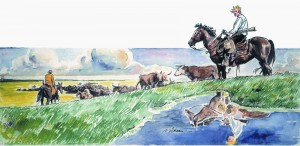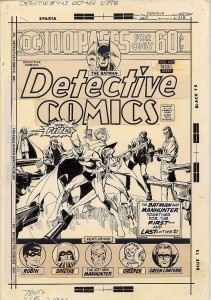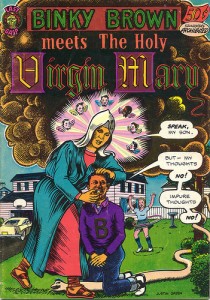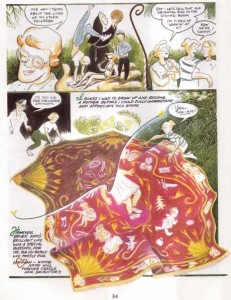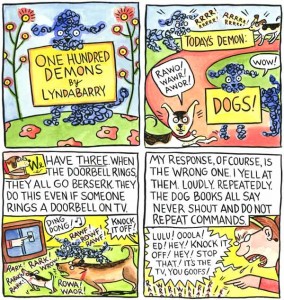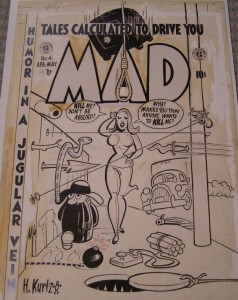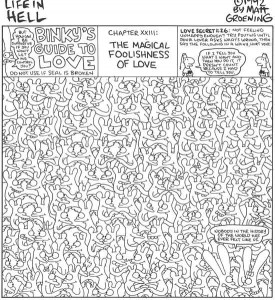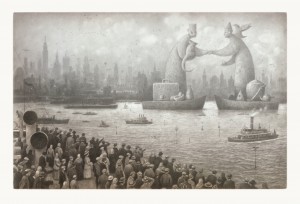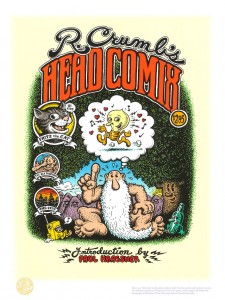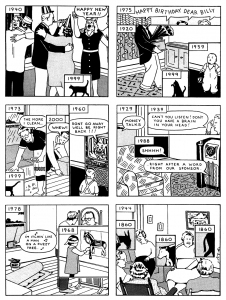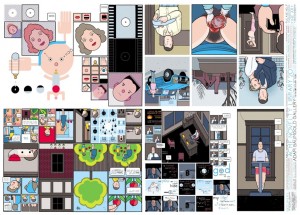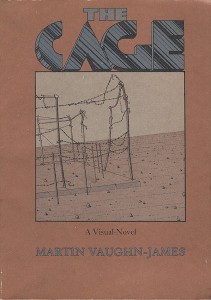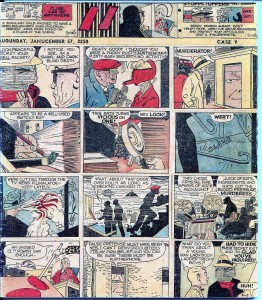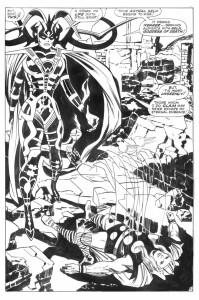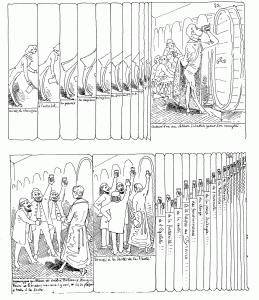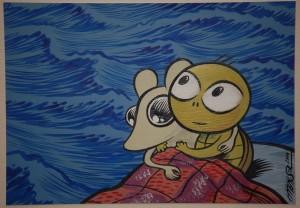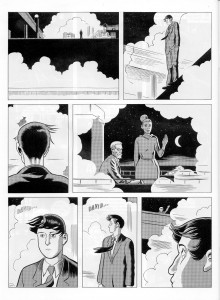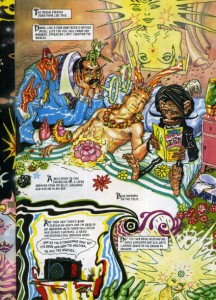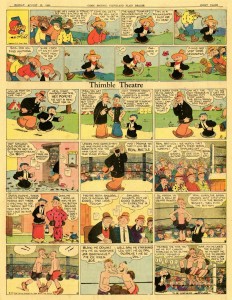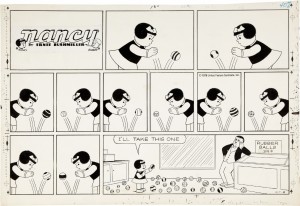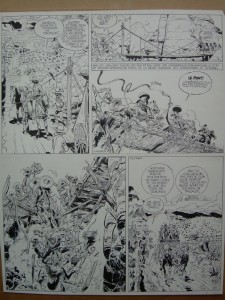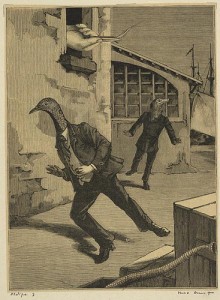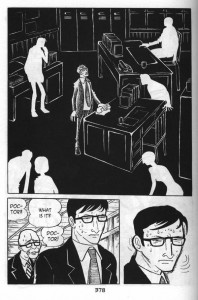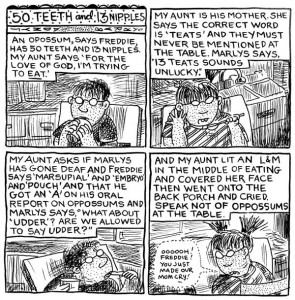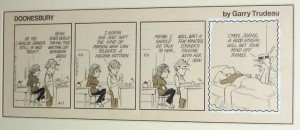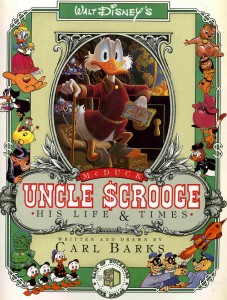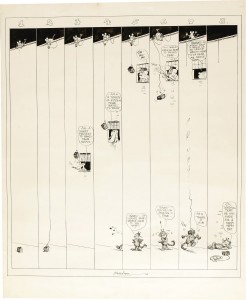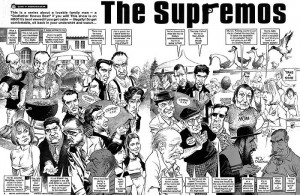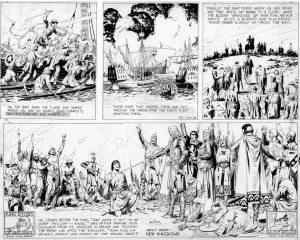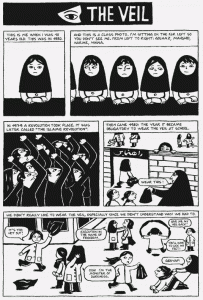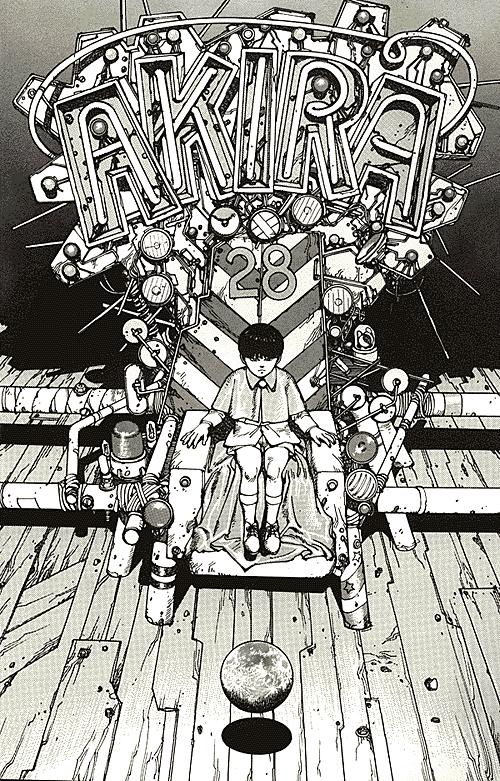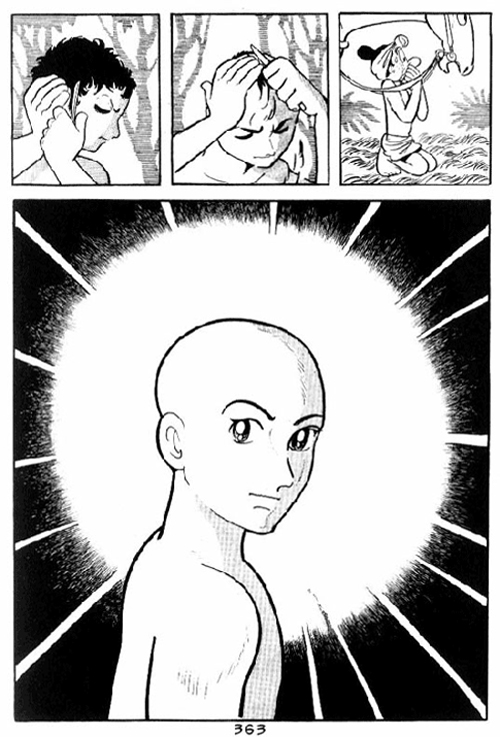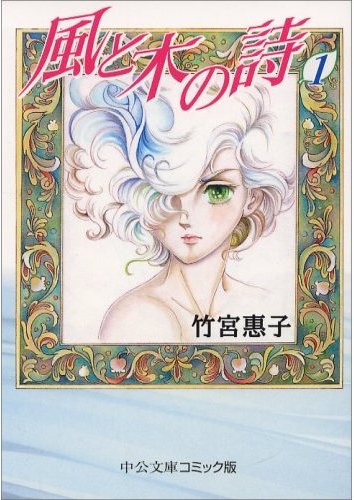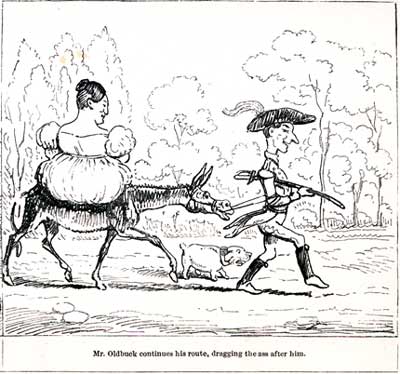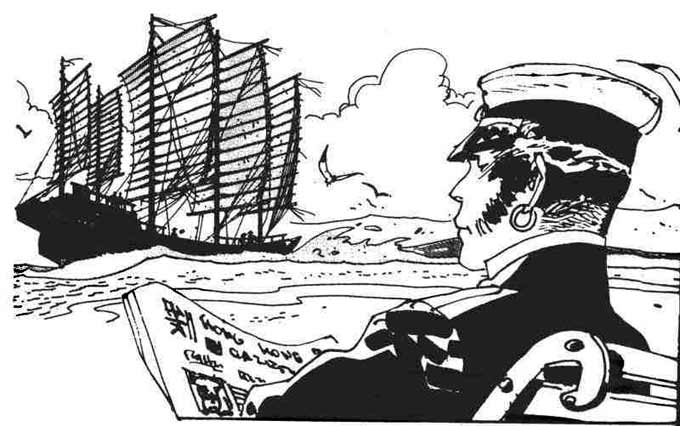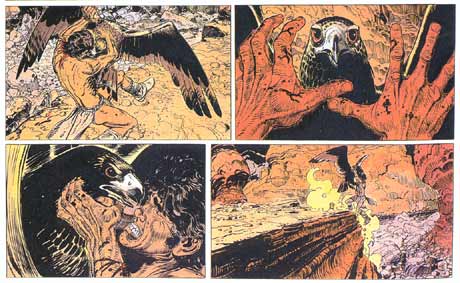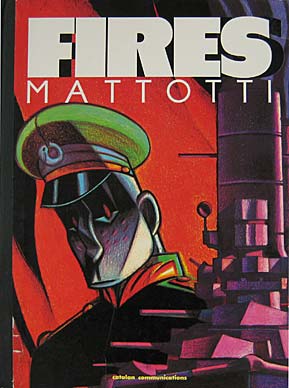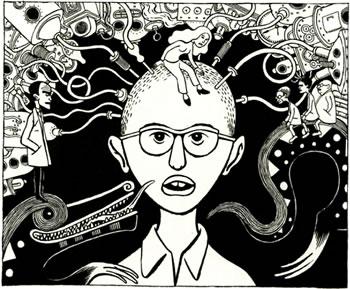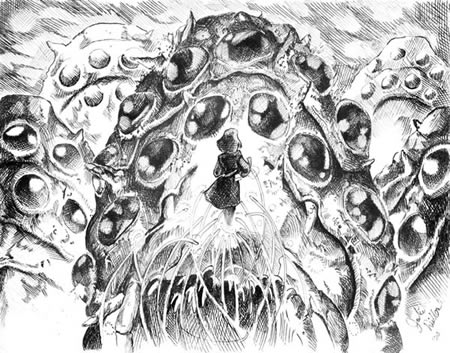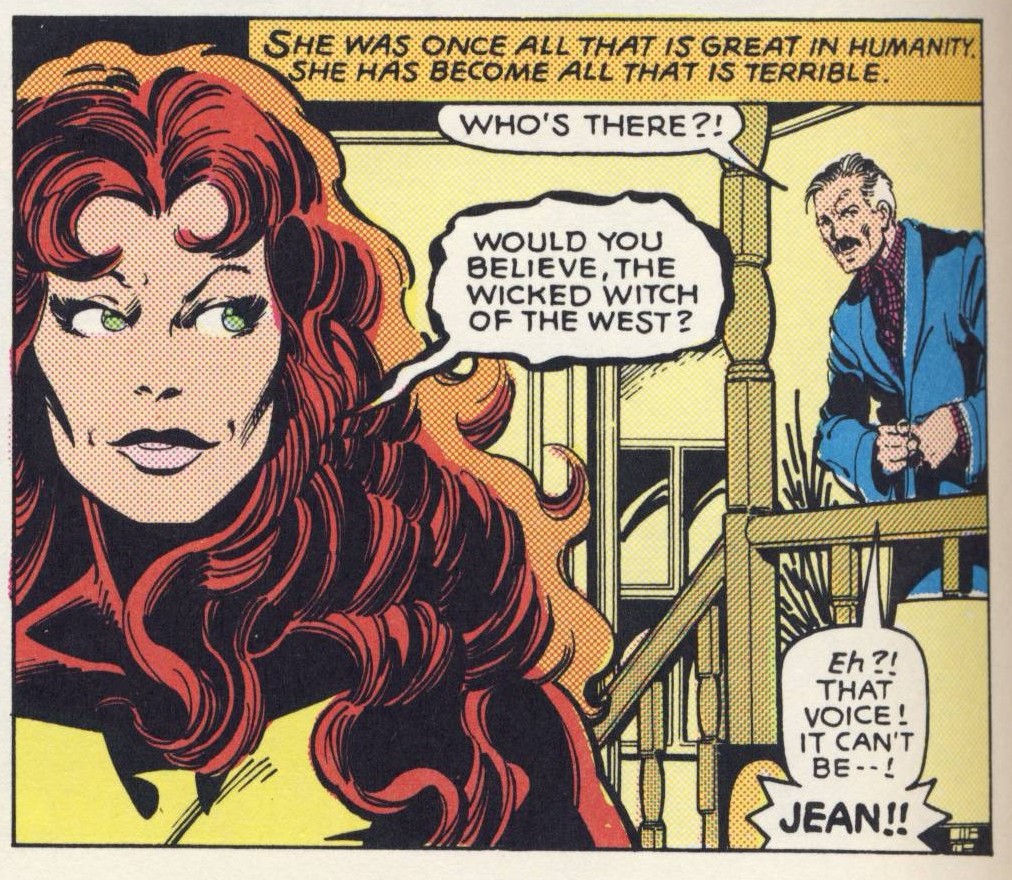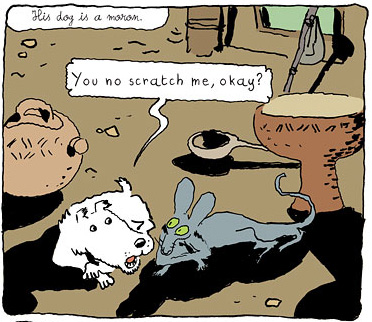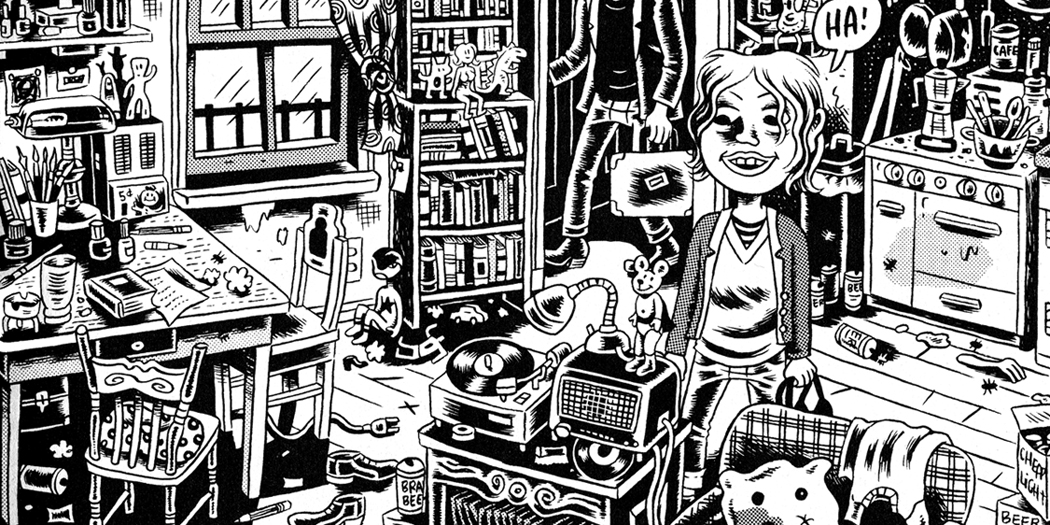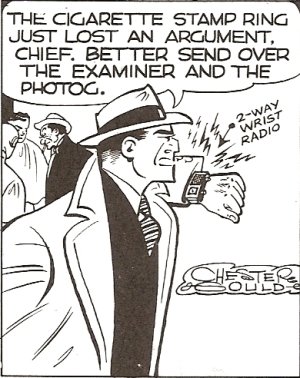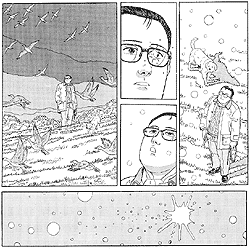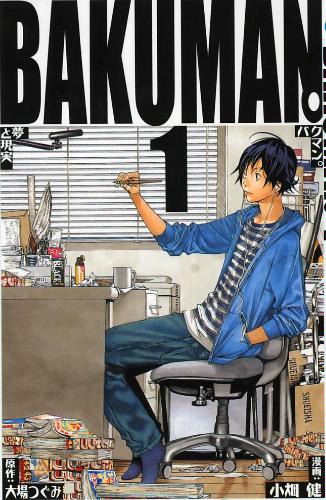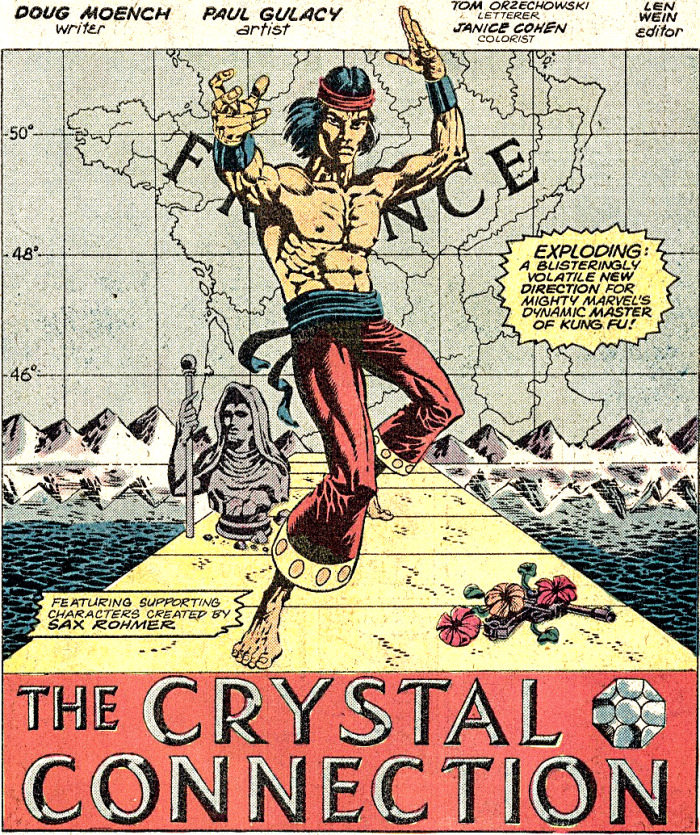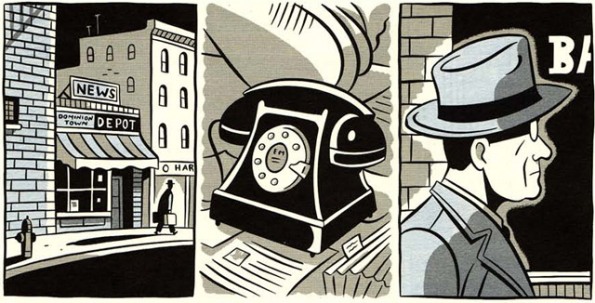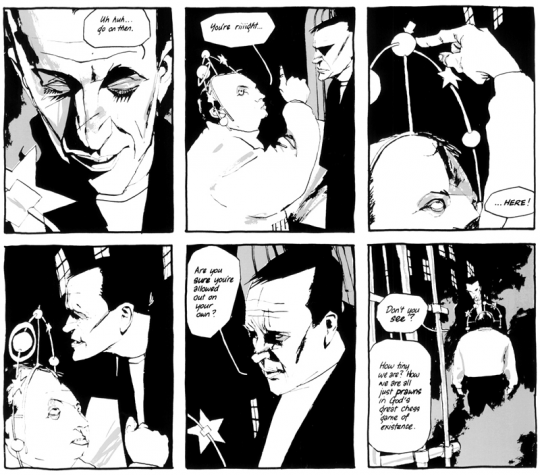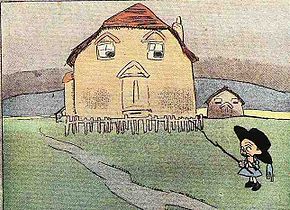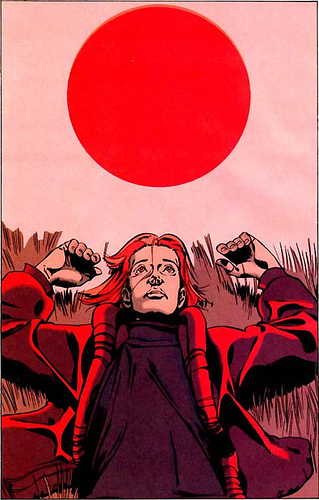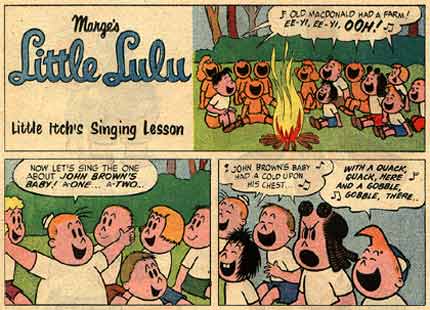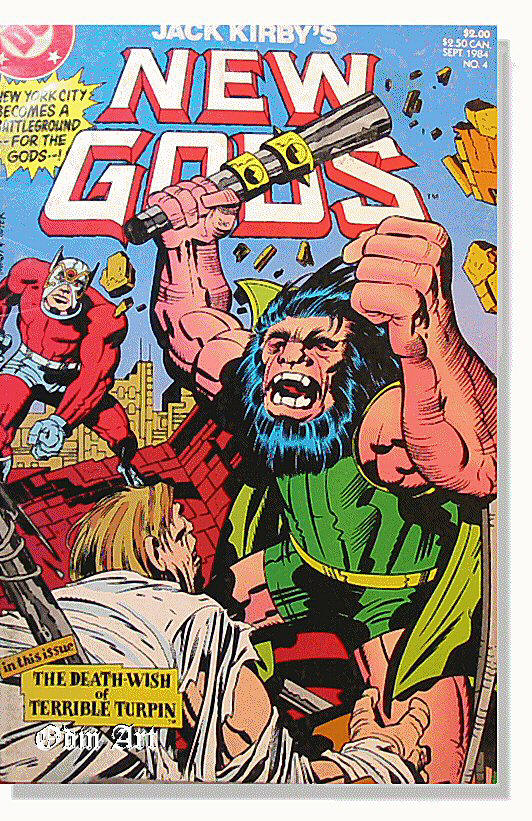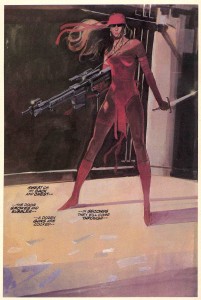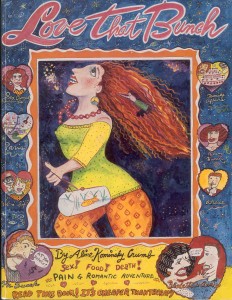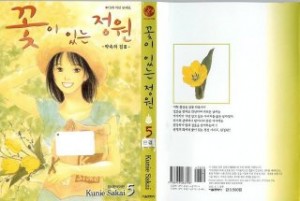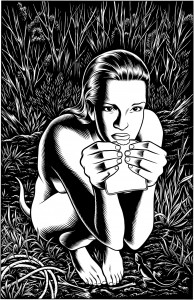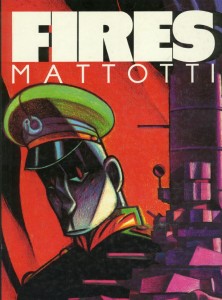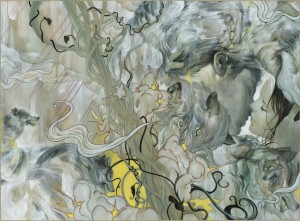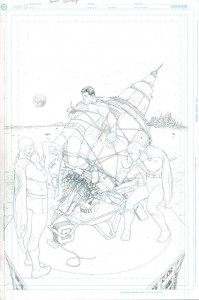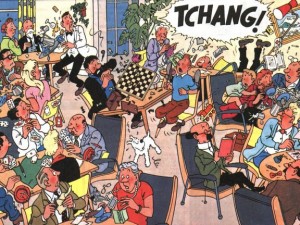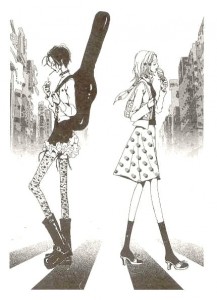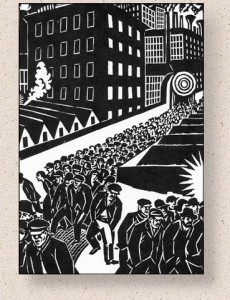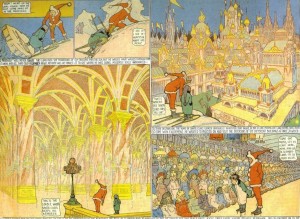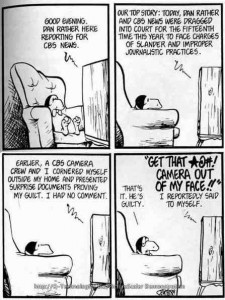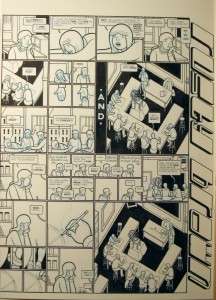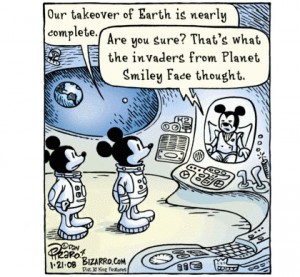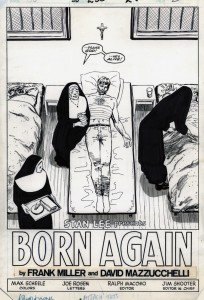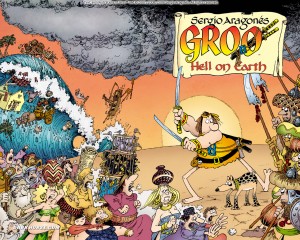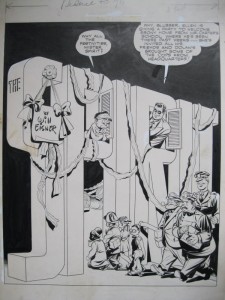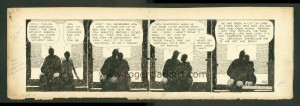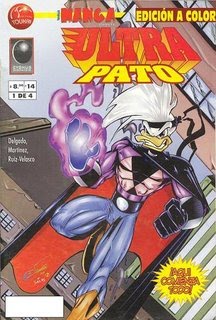The following lists were submitted in response to the question, “What are the ten comics works you consider your favorites, the best, or the most significant?” All lists have been edited for consistency, clarity, and to fix minor copy errors. Unranked lists are alphabetized by title. In instances where the vote varies somewhat with the Top 115 entry the vote was counted towards, an explanation of how the vote was counted appears below it.
In the case of divided votes, only works fitting the description that received multiple votes on their own received the benefit. For example, in Jessica Abel’s list, she voted for The Post-Superhero comics of David Mazzucchelli. That vote was divided evenly between Asterios Polyp and Paul Auster’s City of Glass because they fit that description and received multiple votes on their own. It was not in any way applied to the The Rubber Blanket Stories because that material did not receive multiple votes from other participants.
Flint Hasbudak
Cartoonist, Totuk
Ken Parker, Giancarlo Berardi & Ivo Milazzo
- Akira, Katsuhiro Otomo
- Batman, Bob Kane & Bill Finger, with Jerry Robinson
- Brooklyn Dreams, J. M. DeMatteis & Glenn Barr
- Corto Maltese, Hugo Pratt
- The Creech, Greg Capullo
- Ken Parker, Giancarlo Berardi & Ivo Milazzo
COMMENTS
Tough question! But to put a few in mind, I’ve always admired these.
A list can be very long. And obviously there are many I haven’t read yet.
______________________________________________
Greg Hatcher
Contributing Writer, Comic Book Resources
Detective Comics, Archie Goodwin, et al.
- The Batman Stories, Denny O’Neil & Neal Adams
- Calvin and Hobbes, Bill Watterson
- Daredevil: Born Again, Frank Miller & David Mazzucchelli
- The Defenders Stories, Steve Gerber & Sal Buscema, with Vince Colletta, et al.
- The Fantastic Four, Stan Lee & Jack Kirby, with Joe Sinnott, et al.
- Fax from Sarajevo, Joe Kubert
- From Hell, Alan Moore & Eddie Campbell
- Manhunter, Archie Goodwin & Walter Simonson, and The Batman Stories in Detective Comics #437-443, Archie Goodwin, Steve Englehart, et al.
- The Marvelman [Miracleman] Stories, Alan Moore & Garry Leach, Alan Davis, John Totleben, et al.
- Smile, Raina Telgemaier
COMMENTS
The best comics run of all time? If you mean just character and story, I’d go with the Archie Goodwin-Walt Simonson Manhunter. That was just brilliant. Modern creators are still going back to the stuff, there—ninjas, clones, superheroic anti-heroes that are willing to use lethal force. Not to mention an approach to the art itself that was 20 years ahead of its time. Look at the original Manhunter today, and Simonson’s layout and lettering doesn’t look dated at all.
But really, I’d take it a step further. I’d add that the comics in which those seven Manhunter installments appeared, Detective Comics #437-443, were themselves great comics. Goodwin was writing the Batman lead feature as well, and he kept luring guys like Alex Toth and a young Howard Chaykin to illustrate them, along with stalwarts like Jim Aparo and Dick Giordano. It’s also where you found the original “Night of the Stalker” by Steve Englehart, one of the greatest Batman short stories ever.
[On The Defenders Stories] Social commentary and satire masquerading as Marvel soap opera and amazingly successful today.
[On The Marvelman [Miracleman] Stories] I think Miracleman is a better superhero deconstruction than Watchmen, which (heresy!) hasn’t aged well, and also I’ve gotten so sick of superhero writers cribbing from it that Watchmen is tainted for me. But this is mostly because if you have to choose between Watchmen and Miracleman, Miracleman is better.
[On Smile] This is kind of an upstart entry, but the craft involved just knocks me out, and the entire project serves as a primer of the kind of thing mainstream comics ought to be doing and just…don’t do.
______________________________________________
Charles Hatfield
Associate Professor of English, University of California at Northridge; author, Alternative Comics: An Emerging Literature; contributing writer, The Panelists, The Comics Journal
Binky Brown Meets the Holy Virgin Mary, Justin Green
- L’Ascension du haut-mal [Epileptic], David B.
- Binky Brown Meets the Holy Virgin Mary, Justin Green
- The Book of Jim, Jim Woodring
- “Flies on the Ceiling,” Jaime Hernandez
Counted as a vote for The Locas Stories, Jaime Hernandez - Graffiti Kitchen, Eddie Campbell
Counted as a vote for The Alec Stories, including The Fate of the Artist, Eddie Campbell - “The Hannah Story,” Carol Tyler
- Human Diastrophism [Blood of Palomar], Gilbert Hernandez
Counted as a vote for The Palomar Stories, Gilbert Hernandez - Peanuts, Charles M. Schulz (especially circa 1955-1965)
- “Spawn,”, “The Glory Boat!”, “The Pact!”, and “The Death Wish of Terrible Turpin!”, Jack Kirby, with Mike Royer
Counted as a vote for The Fourth World Stories, Jack Kirby, with Mike Royer, et al. - Thimble Theatre, starring Popeye, E. C. Segar
______________________________________________
David Heatley
Cartoonist, Deadpan, My Brain Is Hanging Upside Down; contributing artist, The New Yorker, The New York Times
“The Hannah Story,” Carol Tyler
- 1. “The Hannah Story,” Carol Tyler
- 2. Maus: A Survivor’s Tale, Art Spiegelman
- 3. Fun Home, Alison Bechdel
- 4. Quimby the Mouse, Chris Ware
- 5. Twentieth-Century Eightball, Daniel Clowes
- 6. Black Hole, Charles Burns
- 7. Collected Works, Volumes 1-5, Shigeru Seguira
- 8. My Trouble with Women, R. Crumb
Counted as a vote for The Weirdo-Era Stories, R. Crumb - 9. Jimbo in Paradise, Gary Panter
- 10. I Never Liked You, Chester Brown
COMMENTS
I hate having to actually rank these because this kind of thing changes all the time in my head. Here’s a stab at it though.
Runners-up: Peanuts (1950s era), Charles M. Schulz; Perfect Example, John Porcellino; The ACME Novelty Library, Chris Ware; Affiches—film posters by Albert Dubout; Wilson, Daniel Clowes; My New York Diary, Julie Doucet; Norakuro, Suiho Tagawa; Dirtbag (mini zines), Dave Kiersh; Annual Illustrated Calendars, Leif Goldberg; Binky Brown Meets the Holy Virgin Mary, Justin Green; It’s a Good Life, If You Don’t Weaken, Seth; “Bomb Scare”, Adrian Tomine; Schizo, Ivan Brunetti; Nowhere, Debbie Drechsler
______________________________________________
Jeet Heer
Co-editor, A Comics Studies Reader, Arguing Comics: Literary Masters on a Popular Medium; contributing writer, Comics Comics, The Comics Journal
ONE! HUNDRED! DEMONS!, Lynda Barry
- 1. Krazy Kat, George Herriman
- 2. Peanuts, Charles M. Schulz
- 3. Maus: A Survivor’s Tale, Art Spiegelman
- 4. Bob ‘n’ Harv’s Comics, Harvey Pekar & R. Crumb
Counted as a vote for American Splendor, Harvey Pekar, with R. Crumb, et al. - 5. Jimmy Corrigan: The Smartest Kid on Earth, Chris Ware
- 6. ONE! HUNDRED! DEMONS!, Lynda Barry
- 7. The Locas Stories, Jaime Hernandez
- 8. The Palomar Stories, Gilbert Hernandez
- 9. I Never Liked You, Chester Brown
- 10. My New York Diary, Julie Doucet
______________________________________________
Danny Hellman
Contributing illustrator, The Village Voice, Guitar World
Alack Sinner, José Muñoz & Carlos Sampayo
- Alack Sinner, José Muñoz & Carlos Sampayo
- Captain Marvel, C. C. Beck & Otto Binder, et al.
- Chandler: Red Tide, Jim Steranko
- A Contract with God and Other Tenement Stories, Will Eisner
- The EC Comics Stories, Wallace Wood, et al.
Counted as a 0.33 vote each for The EC Comics Science-Fiction Stories, Al Feldstein & Wallace Wood, Al Williamson, Joe Orlando, et al., The EC Comics War Stories, Harvey Kurtzman & Jack Davis, John Severin, Wallace Wood, et al., and MAD #1-28, Harvey Kurtzman & Will Elder, Wallace Wood, Jack Davis, et al. - The Fantastic Four, Stan Lee & Jack Kirby, with Joe Sinnott, et al.
- Le Garage hermétique [The Airtight Garage], Jean “Moebius” Giraud
- Little Nemo in Slumberland, Winsor McCay
- The MAD Stories, Mort Drucker
- The Zap Comix stories, R. Crumb
Counted as a vote for The Counterculture-Era Stories, R. Crumb
COMMENTS
This list is all about the art; screw the writers. [Note: Danny Hellman only included the names of the cartoonists/pencilers in his lists above and below. The editor added the names of separate scriptwriters and inkers. This was done for the sake of completeness and editorial consistency.]
And some highly honorable mentions: Abandoned Cars, Tim Lane; The Arcade Stories, Spain Rodriguez; Batman: The Killing Joke, Alan Moore & Brian Bolland; The Captain Marvel, Jr. Stories, Mac Raboy, et al.; Cheech Wizard, Vaughn Bodé; Cochlea and Eustachia, Hans Rickheit; Coochy Cooty, Robert Williams; Ed the Happy Clown, Chester Brown; El Borbah, Charles Burns; The Howard the Duck Stories, Steve Gerber & Gene Colan, with Steve Leialoha, et al.; Idyl, Jeffrey Catherine Jones; The Incal, Alexandro Jodorowsky & Jean “Moebius” Giraud; Maakies, Tony Millionaire; The MAD Stories, Bob Clarke; The MAD Stories, Paul Coker, Jr.; The MAD Stories, Harvey Kurtzman & Will Elder; The Metamorpho Stories, Bob Haney & Ramona Fradon; The Nick Fury, Agent of S.H.I.E.L.D. Stories, Jim Steranko; The Spirit, Will Eisner; Snappy Sammy Snoot, Skip Williamson; Trashman, Spain Rodriguez; Trots and Bonnie, Shary Flenniken
______________________________________________
Sam Henderson
Cartoonist, Magic Whistle
MAD, Harvey Kurtzman, et al.
- Books, B. Kliban
- The Complete Crumb Comics, R. Crumb
Counted a 0.5 vote each for The Counterculture-Era Stories, R. Crumb, and The Weirdo-Era Stories, R. Crumb - The Dell Comics Stories, John Stanley, et al.
Counted as a vote for The Little Lulu Stories, John Stanley, with Irving Tripp - The Fourth World Stories, Jack Kirby, with Mike Royer, et al.
- Krazy Kat, George Herriman
- MAD #1-28, Harvey Kurtzman & Will Elder, Wallace Wood, Jack Davis, et al.
- Nancy, Ernie Bushmiller
- Peanuts, Charles M. Schulz
- Pogo, Walt Kelly
- Thimble Theatre, starring Popeye, E. C. Segar
______________________________________________
Alex Hoffman
Cartoonist, Libertarian Rabbits from Outer Space; Editorial cartoonist, When Falls the Coliseum
Life in Hell, Matt Groening
- Angora Napkin, Troy Little
- The Book of Grickle, Graham Annable
- Calvin and Hobbes, Bill Watterson
- The Editorial Cartoons, Eric Allie
- The Editorial Cartoons, David Horsey
- The Editorial Cartoons, Michael Ramirez
- Everybody Is Stupid Except for Me and Other Astute Observations, Peter Bagge
- Life in Hell, Matt Groening
- Saturday Morning Breakfast Cereal, Zach Weiner
- Watchmen, Alan Moore & Dave Gibbons
______________________________________________
Ben Horak
Cartoonist, Grump Toast
The Arrival, Shaun Tan
- The Arrival, Shaun Tan
- Berlin, Jason Lutes
- The Blot, Tom Neely
- Brat Pack, Rick Veitch
- Ed the Happy Clown, Chester Brown
- The Frank Stories, Jim Woodring
- The Left Bank Gang, Jason
- Panorama of Hell, Hideshi Hino
- Percy Gloom, Cathy Malkasian
- Six Hundred Seventy-Six Apparitions of Killoffer, Patrice Killoffer
______________________________________________
Kenneth Huey
Contributing cartoonist, Commies from Mars; Illustrator; “Humanoid,” Church of the Subgenius
Head Comix, R. Crumb
- The Conan the Barbarian Stories, Roy Thomas & Barry Windsor-Smith, with Sal Buscema, et al.
- Le Garage hermétique [The Airtight Garage], Jean “Moebius” Giraud
- Head Comix, R. Crumb
Counted as a vote for The Counterculture-Era Stories, R. Crumb - Little Nemo in Slumberland, Winsor McCay
- The Nick Fury, Agent of S.H.I.E.L.D Stories, Jim Steranko, with Joe Sinnott, et al.
- Pogo, Walt Kelly
- The Sandman, Jack Kirby & Joe Simon, with Michael Fleisher, et al.
- Tarzan of the Apes (graphic novel), Burne Hogarth
- Torpedo 1936, Enrique Sánchez Abulí & Jordi Bernet
- The X-Men Stories, Roy Thomas & Neal Adams, with Tom Palmer, et al.
COMMENTS
Any “best of” list naturally invites a vigorous “sez who?” After all, who among us is truly qualified to judge the comparative importance of, say Lyonel Feininger’s The Kin-der-Kids vs. John Byrne’s run on The Fantastic Four? So, I’ll do something a bit more modest. Off the top of my head, these are ten features that have meant a lot to me over the years.
______________________________________________
Jelle Hugaerts
Contributing writer, Forbidden Planet International
Conte démoniaque, Aristophane
- Bar Miki, Michelangelo Setola
- Conte démoniaque [Demonic Tale], Aristophane
- Cowboy Henk, Kamagurka & Herr Seele
- Eläkeläinen muistelee [Memoirs of a Pensioner], Kalervo Palsa
- “Gynecology,” Daniel Clowes
Counted as a vote for Caricature: Nine Stories, Daniel Clowes - I Never Liked You, Chester Brown
- Jimmy Corrigan: The Smartest Kid on Earth, Chris Ware
- Kraut, Peter Pontiac
- Le Monde d’Edena [The World of Edena], Jean “Moebius” Giraud
- Teratoid Heights, Mat Brinkman
______________________________________________
Mike Hunter
Contributing writer, The Hooded Utilitarian
“Here,” Richard McGuire
- From Hell, Alan Moore & Eddie Campbell
- “Here,”, Richard McGuire
- “Hypothetical Quandary,” Harvey Pekar & R. Crumb
Counted as a vote for American Splendor, Harvey Pekar, with R. Crumb, et al. - “L,” Eric Drooker
- “Patton” and “The Religious Experience of Philip K. Dick,” R. Crumb
Counted as a vote for The Weirdo-Era Stories, R. Crumb - “Secret Lords of the DNA,” Del Close, John Ostrander, and David Lloyd
- “Ten Minutes”, Will Eisner, with Jules Feiffer
Counted as a vote for The Spirit, Will Eisner - “Those Who Change,”, Stan Lee & Steve Ditko
- Watchmen, Alan Moore & Dave Gibbons
- “What the Left Hand Did,” Jim Woodring
Counted as a vote for The Book of Jim, Jim Woodring
______________________________________________
“Illogical Volume”
Contributing writer, Mindless Ones
“Lint,” Chris Ware
- The Alec Stories, including/especially The Fate of the Artist, Eddie Campbell
- Birdland, Gilbert Hernandez
- The Fourth World Stories, including/especially The Hunger Dogs, Jack Kirby, with Mike Royer, et al.
- The Invisibles and The Filth, Grant Morrison & Steve Yeowell, et al.
- Krazy Kat, George Herriman
- “Lint,” Chris Ware
- Pluto, Naoki Urasawa
- Solo #12, Brendan McCarthy, et al.
- Transformers: Time Wars, Simon Furman, et al.
- The X-Force Stories, Peter Milligan & Mike Allred, with Laura Allred
______________________________________________
Domingos Isabelinho
Contributing writer, The Hooded Utilitarian
The Cage, Martin Vaughn-James
- Amapola Negra [Black Poppy], Héctor Germán Oesterheld & Francisco Solano López
- The Cage, Martin Vaughn-James
- Conte démoniaque, Aristophane
- Die Hure H [W the Whore], Katrin de Vries & Anke Feuchtenberger
- Journal (3), Fabrice Neaud
- Le Journal de Jules Renard lu par Fred [The Diary of Jules Renard as Read by Fred], Jules Renard & Fred
- Mûno no Hito [The Talentless Man], Yoshiharu Tsuge
- La orilla [The Shore], Elisa Galvez & Federico del Barrio
- Sa-Lo-Món, Santiago “Chago” Armada
- Zil Zelub, Guido Buzzelli
COMMENTS
Here’s my top ten (restrict comics field). If my top ten included things from the expanded field it would look quite diffrent with things like: Jacques Callot (Les Misères et malheurs de la guerre [The Miseries and Misfortunes of War]); Francisco de Goya (Los Desastres de la Guerra [The Disasters of War]), Los Caprichos [The Caprices]); Katsushika Hokusai (Fugaku Sanjûrokkei [Thirty-Six Views of Mt. Fuji], Fugaku Hyakkei [One Hundred Views of Mt. Fuji]); Charlotte Salomon (Leben? oder Theater? [Life? Or Theater?]); Francis Bacon (Triptych May-June 1973); William Hogarth (A Harlot’s Progress, A Rake’s Progress); Pablo Picasso (Songe et mensonge de Franco [Dream and Lie of Franco]).
______________________________________________
Cole Johnson
Cartoonist, Sleepover Comics
Tricky Cad, Jess
- The Bungle Family, H. J. Tuthill
- Buzzbomb, Kaz
- Cowboy Henk, Herr Seele and Kamagurka
- Maria no Komon [Mary’s Asshole], Hanako Yamada
- Nancy, Ernie Bushmiller
- Nekojiru Udon, Nekojiru
- Remue Ménage, Anna Sommer
- Rthym Mastr, Kerry James Marshall
- Tricky Cad, Jess
______________________________________________
“Jones, One of the Jones Boys”
Writer, Let’s You and Him Fight
Thor, Jack Kirby & Stan Lee
- The ACME Novelty Library, Chris Ware
Counted as a 0.25 vote each for “Building Stories,” Jimmy Corrigan: The Smartest Kid on Earth, Quimby the Mouse, and Rusty Brown, including “Lint” - Cerebus, Dave Sim & Gerhard
- Donjon [Dungeon], Joann Sfar & Lewis Trondheim, et al.
- The Frank Stories, Jim Woodring
- Fungus the Bogeyman, Raymond Briggs
- The Little Lulu Stories, John Stanley & Irving Tripp
- Little Nemo in Slumberland, Winsor McCay
- Seven Soldiers of Victory, Grant Morrison, et al.
- Thor, including “Tales of Asgard”, Jack Kirby & Stan Lee, with Larry Lieber, et al.
- Various manga, Shintaro Kago
COMMENTS
MASSIVE DISCLAIMER: You’ve asked for “the ten comics works you consider your favorites, the best, or the most significant,” and this is a list of my favourite comics as of 29 June 2011. It sure as hell isn’t the ten “best” comics!
______________________________________________
Bill Kartalopoulos
Instructor, Parsons The New School for Design; programming coordinator, Small Press Expo; contributing editor, Print magazine
Histoire d’Albert, Rodolphe Töpffer
- Alias the Cat, Kim Deitch
- Caricature: Nine Stories, Daniel Clowes
- The EC Comics War Stories, Harvey Kurtzman (the stories Kurtzman drew himself)
- “Here,” Richard McGuire
- Histoire d’Albert [The Story of Albert], Rodolphe Töpffer
Counted as a vote for Works, Rodolphe Töpffer - Krazy Kat, George Herriman
- Maus: A Survivor’s Tale, Art Spiegelman
- Paul Auster’s City of Glass, Paul Karasik & David Mazzucchelli
- Rusty Brown, Chris Ware
- Travel, Yuichi Yokoyama
______________________________________________
Megan Kelso
Cartoonist, Artichoke Tales, Queen of the Black Black
Goodbye, Chunky Rice, Craig Thompson
- 1. ONE! HUNDRED! DEMONS!, Lynda Barry
- 2. Dirty Plotte, Julie Doucet
- 3. Ghost World, Daniel Clowes
- 4. I Never Liked You, Chester Brown
- 5. Perfect Example, John Porcellino
- 6. Skibber Bee Bye, Ron Regé, Jr.
- 7. Cave-In, Brian Ralph
- 8. Shrimpy and Paul, Marc Bell
- 9. Goodbye, Chunky Rice, Craig Thompson
- 10. Palestine, Joe Sacco
______________________________________________
Abhay Khosla
Contributing writer, The Savage Critics
“Master Race,” Bernard Krigstein & Al Feldstein
- The ACME Novelty Library, Chris Ware
Counted as a 0.25 vote each for “Building Stories,” Jimmy Corrigan: The Smartest Kid on Earth, Quimby the Mouse, and Rusty Brown, including “Lint” - Calvin and Hobbes, Bill Watterson
- The Fourth World Stories, Jack Kirby, with Mike Royer, et al.
- From Hell, Alan Moore & Eddie Campbell
- Go Go Monster, Taiyo Matsumoto
- Little Nemo in Slumberland, Winsor McCay
- “Master Race,” Bernard Krigstein & Al Feldstein
- The New Yorker Cartoons, Charles Addams
- The Palomar Stories, Gilbert Hernandez
- Peanuts, Charles M. Schulz
COMMENTS
I don’t want to overthink this because otherwise this’ll turn into a thing with me… Also: I question that lists like these are a good idea. But whatever, who cares. Thanks for asking. Oh: if I have to pick just one, for The Fourth World, let’s go with The New Gods. But that would be the incorrect way of looking at that work, and not how I understand they’re being published currently, so I’m going with The Fourth World.
______________________________________________
Molly Kiely
Cartoonist, Tecopa Jane, Saucy Tart
La Perdida, Jessica Abel
- The American State Maps, Ruth Taylor White
- The Biologic Show, Al Columbia
- Krazy Kat, George Herriman
- Li’l Abner, Al Capp
- Peanuts, Charles M. Schulz
- La Perdida, Jessica Abel
- Shôjo Tsubaki [Mr. Arashi’s Amazing Freakshow], Suehiro Maruo
- Steven, Doug Allen
- THB, Paul Pope
- Viaggio a Tulum [Trip to Tulum], Milo Manara & Federico Fellini
______________________________________________
Kinukitty
Contributing writer, The Hooded Utilitarian
Seiyô Kottô Yôgashiten, Fumi Yoshinaga
- Seiyô Kottô Yôgashiten [Antique Bakery], Fumi Yoshinaga
- Calvin and Hobbes, Bill Watterson
- The Doom Patrol Stories, Grant Morrison & Richard Case, with Scott Hanna, et al.
- Gashlycrumb Tinies (and everything else), Edward Gorey
Counted as a vote for Works, Edward Gorey - Let Dai, Sooyeon Won
- Li’l Abner, Al Capp
- Peanuts, Charles M. Schulz
- Le Petit vampire [Little Vampire], Joann Sfar
- Oroka-mono wa Aka o Kirau [Red Blinds the Foolish], est em
- Scary Godmother, Jill Thompson
______________________________________________
T. J. Kirsch
Co-creator & illustrator, Uncle Slam Fights Back; illustrator, She Died in Terrebonne
David Boring, Daniel Clowes
- Asterios Polyp, David Mazzucchelli
- Calvin and Hobbes, Bill Watterson
- David Boring, Daniel Clowes
- Ghost World, Daniel Clowes
- Hicksville, Dylan Horrocks
- I Never Liked You, Chester Brown
- Krazy Kat, George Herriman
- Maus: A Survivor’s Tale, Art Spiegelman
- Peanuts, Charles M. Schulz
- The Playboy, Chester Brown
______________________________________________
Sean Kleefeld
Writer, Kleefeld on Comics
Understanding Comics, Scott McCloud
- Calvin and Hobbes, Bill Watterson
- Complete Works, Joe Sacco
Counted as a vote for Palestine, Joe Sacco - The Fantastic Four, Stan Lee & Jack Kirby, with Joe Sinnott, et al.
- The Fantastic Four Stories, John Byrne
- The Green Lantern/Green Arrow Stories, Denny O’Neil & Neal Adams, with Dick Giordano, et al.
- Judge Dredd, John Wagner & Carlos Ezquerra
- Little Nemo in Slumberland, Winsor McCay
- Kozure Ôkami [Lone Wolf and Cub], Kazuo Koike & Goseki Kojima
- Tozo the Public Servant, David O’Connell
- Understanding Comics, Scott McCloud
__________

